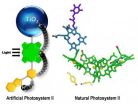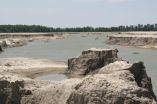(Press-News.org) Researchers studying peptides using the Gordon supercomputer at the San Diego Supercomputer Center (SDSC) at the University of California, San Diego (UCSD) have found new ways to elucidate the creation of the toxic oligomers associated with Alzheimer's disease.
Igor Tsigelny, a research scientist with SDSC, the UCSD Moores Cancer Center, and the Department of Neurosciences, focused on the small peptide called amyloid-beta, which pairs up with itself to form dimers and oligomers.
The scientists surveyed all the possible ways to look at the dynamics of conformational changes of these peptides and the possibility that they might organize into the oligomers theorized to be responsible for the degenerative brain disease. In the February 14 issue of the Journal of Alzheimer's Disease, the researchers suggest their results may generate new targets for drug development.
"Our research has identified amino acids for point mutations that either enhanced or suppressed the formation and toxicity of oligomer rings," said Tsigelny, the study's lead author. "Aggregation of misfolded neuronal proteins and peptides may play a primary role in neurodegenerative disorders, including Alzheimer's disease."
Tsigelny also noted that recent improvements in computational processing speed have allowed him and other researchers to use a variety of tools, including computer simulations, to take new approaches to examining amyloid-beta, which has proven too unstable for traditional approaches such as x-ray crystallography.
The researchers investigated the single and dimer forms of the peptide with a combination of computational methods including molecular dynamics, molecular docking, molecular interactions with the membrane, as well as mutagenesis, biochemical, and electron microscopy studies. They then looked at how those dimers interacted with additional peptides and which larger structures resulted. The researchers found that depending on their configurations, some dimers did not lead to any further oligomerization and some form toxic oligomers implicated in the development of Alzheimer's disease.
"Remarkably, we showed a greater diversity in amyloid-beta dimers than previously described," said Eliezer Masliah, professor of pathology and medicine at UC San Diego, and a member of the research team. "Understanding the structure of amyloid-beta dimers might be important for the design of small molecules that block formation of toxic oligomers."
Based on their results, the researchers were able to identify key amino acids that altered the formation and toxicity of oligomer rings. "Our data is only theoretical, but there is a good chance the oligomers we have been modeling exist for real," noted Masliah. "Some important recent publications have come out that support our work."
The in silico experiments allowed the single amyloid-beta monomers to associate randomly, according to Masliah. However, he noted that within the brains of Alzheimer's patients, the formation of oligomers and fibrils depends on any number of biochemical influences such as peptide concentration, oxidation, neurotoxins, and acidity.
According to the researchers, their work implicates a more dynamic role for the amyloid-beta dimers than previously thought. It also suggests that the way dimers form and then grow into larger structures is a rapidly changing process.
"This, as well as previous results, suggests that targeting selected amyloid-beta dimers may be important in an effort to ameliorate the episodic memory described in mild cognitive impairment and the early stages of Alzheimer's disease," said Masliah.
INFORMATION:
Masliah and Tsigelny's collaborators included UC San Diego's Yuriy Sharikov, Valentina Kouznetsova, Jerry Greenberg, Wolfgang Wrasidlo, Tania Gonzalez, Paula Desplats, Sarah E. Michael, Margarita Trejo-Morales, and Cassia Overk.
SDSC/UC San Diego researchers hone in on Alzheimer's disease
'Gordon' supercomputer helps guide new drug designs
2014-02-18
ELSE PRESS RELEASES FROM THIS DATE:
Artificial leaf jumps developmental hurdle
2014-02-18
In a recent early online edition of Nature Chemistry, ASU scientists, along with colleagues at Argonne National Laboratory, have reported advances toward perfecting a functional artificial leaf.
Designing an artificial leaf that uses solar energy to convert water cheaply and efficiently into hydrogen and oxygen is one of the goals of BISfuel – the Energy Frontier Research Center, funded by the Department of Energy, in the Department of Chemistry and Biochemistry at Arizona State University.
Hydrogen is an important fuel in itself and serves as an indispensible ...
Wistar scientists develop gene test to accurately classify brain tumors
2014-02-18
cientists at The Wistar Institute have developed a mathematical method for classifying forms of glioblastoma, an aggressive and deadly type of brain cancer, through variations in the way these tumor cells "read" genes. Their system was capable of predicting the subclasses of glioblastoma tumors with 92 percent accuracy. With further testing, this system could enable physicians to accurately predict which forms of therapy would benefit their patients the most.
Their research was performed in collaboration with Donald M. O'Rourke, M.D., a neurosurgeon at the University ...
COXEN model picks the best drug for ovarian cancer
2014-02-18
There are three common drugs for advanced ovarian cancer: paclitaxel, cyclophosphamide, and topotecan. Like a shell game, if you pick the right drug a patient is likely to respond. And, unfortunately, picking the wrong drug can lead to treatment failure. As reported in this month's issue of the journal PLoS ONE, a University of Colorado Cancer Center and University of Virginia study used a sophisticated model of ovarian cancer genetics to match the right tumor with the right drug. Patients who were matched in this way lived an average 21 months longer than patients who ...
A battery small enough to be injected, energetic enough to track salmon
2014-02-18
RICHLAND, Wash. – Scientists have created a microbattery that packs twice the energy compared to current microbatteries used to monitor the movements of salmon through rivers in the Pacific Northwest and around the world.
The battery, a cylinder just slightly larger than a long grain of rice, is certainly not the world's smallest battery, as engineers have created batteries far tinier than the width of a human hair. But those smaller batteries don't hold enough energy to power acoustic fish tags. The new battery is small enough to be injected into an organism and holds ...
Controlling magnetism with an electric field
2014-02-18
Coral Gables, Fla. (Feb. 17, 2014) -- There is a big effort in industry to produce electrical devices with more and faster memory and logic. Magnetic memory elements, such as in a hard drive, and in the future in what is called MRAM (magnetic random access memory), use electrical currents to encode information. However, the heat which is generated is a significant problem, since it limits the density of devices and hence the performance of computer chips.
Scientists are now proposing a novel approach to achieve greater memory density while producing less heat: by using ...
University of Illinois study of 2011 flood will lead to better preparedness
2014-02-18
In May 2011, when the U.S. Army Corps of Engineers used explosives to breach a levee south of Cairo, Ill., diverting the rising waters of the Mississippi and Ohio rivers to prevent flooding in the town, about 130,000 acres of Missouri farmland were inundated. It was the largest flood of the lower Mississippi ever recorded, and researchers from the University of Illinois at Urbana-Champaign took advantage of this "once-in-a-scientific-lifetime" occurrence to study the damage, funded by a National Science Foundation Rapid Response Grant. Their results, published this week ...
Embarking on geoengineering, then stopping, would speed up global warming
2014-02-18
Spraying reflective particles into the atmosphere to reflect sunlight and then stopping it could exacerbate the problem of climate change, according to new research by atmospheric scientists at the University of Washington.
Carrying out geoengineering for several decades and then stopping would cause warming at a rate that will greatly exceed that expected due to global warming, according to a study published Feb. 18 in Environmental Research Letters.
"The absolute temperature ends up being roughly the same as what it would have been, but the rate of change is so drastic, ...
In fight against teen prescription drug abuse, one-two punch wins
2014-02-18
DURHAM, N.C. -- Programs that aim to curb teen prescription drug abuse have vastly differing effectiveness, ranging from big drops in drug abuse to no measurable effect, according to a new study of 11,000 teenagers by researchers at Duke and Pennsylvania State universities.
The best results came from pairing a school-based program with a home-based intervention, resulting in a 10 percent decrease in abuse rates. By contrast, most school-based programs were ineffective when used by themselves, with just one exception.
The six-year study is among the first to measure ...
Research team establishes benchmark set of human genotypes for sequencing
2014-02-18
Led by biomedical engineer Justin Zook of the National Institute of Standards and Technology, a team of scientists from Harvard University and the Virginia Bioinformatics Institute of Virginia Tech has presented new methods to integrate data from different sequencing platforms, thus producing a reliable set of genotypes to benchmark human genome sequencing.
"Understanding the human genome is an immensely complex task and we need great methods to guide this research," Zook says. "By establishing reference materials and gold standard data sets, scientists are one step closer ...
Smartphone app aids college-age women in abusive relationships
2014-02-18
COLUMBIA, Mo. –Women between the ages of 18 and 24 are at the highest risk for dating violence, according to the Centers for Disease Control and Prevention. However, these women are less likely than older adults to seek formal safety resources and instead look to peers or technology for help and advice. In an effort to connect more young women with safety information, University of Missouri researchers collaborated with Johns Hopkins University School of Nursing and the One Love Foundation to develop the "One Love My Plan" smartphone application, an interactive tool that ...
LAST 30 PRESS RELEASES:
Duke and Duke-NUS’ joint cross-population research to uncover "East-West" differences in disease and care
Scientists to ‘spy’ on cancer- immune cell interactions using quantum technology breakthrough
Tech savvy users have most digital concerns
Making lighter work of calculating fluid and heat flow
Normalizing blood sugar can halve heart attack risk
Lowering blood sugar cuts heart attack risk in people with prediabetes
Study links genetic variants to risk of blinding eye disease in premature infants
Non-opioid ‘pain sponge’ therapy halts cartilage degeneration and relieves chronic pain
AI can pick up cultural values by mimicking how kids learn
China’s ecological redlines offer fast track to 30 x 30 global conservation goal
Invisible indoor threats: emerging household contaminants and their growing risks to human health
Adding antibody treatment to chemo boosts outcomes for children with rare cancer
Germline pathogenic variants among women without a history of breast cancer
Tanning beds triple melanoma risk, potentially causing broad DNA damage
Unique bond identified as key to viral infection speed
Indoor tanning makes youthful skin much older on a genetic level
Mouse model sheds new light on the causes and potential solutions to human GI problems linked to muscular dystrophy
The Journal of Nuclear Medicine ahead-of-print tip sheet: December 12, 2025
Smarter tools for peering into the microscopic world
Applications open for funding to conduct research in the Kinsey Institute archives
Global measure underestimates the severity of food insecurity
Child survivors of critical illness are missing out on timely follow up care
Risk-based vs annual breast cancer screening / the WISDOM randomized clinical trial
University of Toronto launches Electric Vehicle Innovation Ontario to accelerate advanced EV technologies and build Canada’s innovation advantage
Early relapse predicts poor outcomes in aggressive blood cancer
American College of Lifestyle Medicine applauds two CMS models aligned with lifestyle medicine practice and reimbursement
Clinical trial finds cannabis use not a barrier to quitting nicotine vaping
Supplemental nutrition assistance program policies and food insecurity
Switching immune cells to “night mode” could limit damage after a heart attack, study suggests
URI-based Global RIghts Project report spotlights continued troubling trends in worldwide inhumane treatment
[Press-News.org] SDSC/UC San Diego researchers hone in on Alzheimer's disease'Gordon' supercomputer helps guide new drug designs




